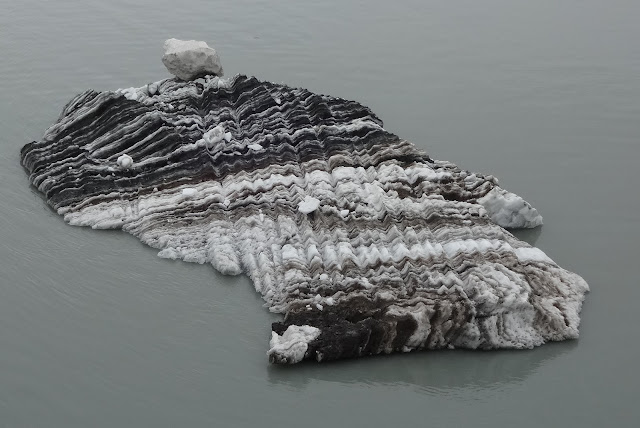On June 29, an overcast day, we spent most of the day in Glacier Bay. The overcast weather was great as the glaciers appeared bluer. I could have gotten up even earlier to start seeing chunks of ice in the bay.
Glacier Bay, the body of water, covers an area 1,375 square miles of glaciers. It was a large
single glacier of solid ice until 250 years ago. A massive river of ice, roughly 100 miles long and thousands of feet deep occupied the entire bay and was known as the Grand Pacific Glacier.
That glacier is now gone, having retreated north. Fewer than a dozen smaller tidewater glaciers remain. They are located at the heads of their inlets in the upper bay.
They calve great shards of ice into the bay. Glacier Bay is now the largest protected
water area park in the world.
Glacier Bay has many branches, inlets, lagoons, islands, and channels
that holds prospects for scientific exploration and visual treat. Thus,
the area is popular as a cruise ship destination during summer season. However, there are restrictions imposed by the National Park Service on the numbers of vessels that can operate in a day to 2 cruise ships, 3 tour boats, 6 charter vessels, and 25 private vessels. (Wikipedia)
Chunks got bigger the farther in we got. I loved the colors!
Aren't they stunning???
 |
| Approaching |
 |
| Getting Closer |
|
 |
| And Closer |
 |
| magnificent colors! |
 |
| I REALLY was there! |
 |
| A Favorite Shot! I caught the bird as it flew by! |
Johns Hopkins Glacier (from Wikipedia)
The Johns Hopkins Glacier rises from the Fairweather Range on the east slopes of Lituya Mt
and Mt. Salisbury and has a westerly flow towards the head of Johns Hopkins inlet, 1 mile southwest of the
terminus of Clark Glacier. Its rock, ice and snow depict a variety of impressive colors such as grey, blue and white. It was named in 1893 after the Johns Hopkins University
,
which sponsored an expedition to this glacier. It is the only advancing
tidewater glacier now (its advance started in 1924 when Grand Pacific
Glacier started receding towards Tarr Inlet) and is combined with Gilman
Glacier (first got attached to Hopkins in the 1990s, broke off and
rejoined several times and once again it appears joined since 2000);
both are advancing as one single ice block, and at the waterfront, has a
width of 1 mile (1.6 km) with a depth of 250 feet (76 m), rises to a
height of 250 feet (76 m) and stretches to about 12 miles (19 km)
upstream. Submarine calving has also been recorded.
The Johns Hopkins Glacier, for example, cannot be approached any
nearer than about 2 miles (3.2 km) by sea because of the volume of the
ice blocks that break loose from its cliffs. Most visitors to the park
come by cruise ship and thus view the glaciers from the water.
 |
| Approaching JH glacier |
 |
| Getting Closer |
|
|
|
|
 |
| Frozen waterfall near JH glacier |
 |
| Stunning, isn't it? |
The colors are magnificent!
Approaching Johns Hopkins Glacier
 |
| Black glacier to right and up |
We entered the southern part of Glacier Bay at 6"\:30 a.m. We saw the most spectacular glaciers from about 10:30 a.m. to 1:30 p.m. It was cold...overcast an 51 degrees at noon, according to the ships log. By 4 p.m., we had left the bay and sailed toward Seward. It was an amazing day!




























1 comment:
Dina-
You have done a fabulous job detailing the trip so far! I am really enjoying reading about your experiences in Alaska - you have really captured the essence of each locale, and you have provided a lot of great information. It was a pleasure meeting you, and I look forward to reading about the rest of the trip.
Sarah
Post a Comment